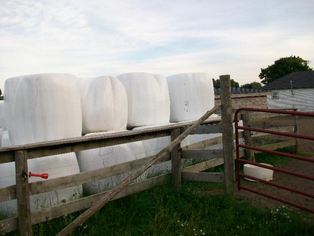



Preventing Baleage Spoilage
Indicators such as bale density and forage moisture can be used to monitor bale quality, according to advisers at the University of Maine.Round bale silage (baleage) is often produced on Maine farms to overcome the difficulty of making high quality dry hay under wet, humid conditions. Incidences of toxicity and death of cattle consuming baleage that has spoiled because of improper bale management can occur.
In West Virginia research project on-farm management and fermentation data was collected to identify the most critical risk factors that contribute to poorly preserved baleage.

Their data showed that success in baleage production can be consistently achieved by following best management practices that emphasize optimum forage moisture (50 to 60 per cent) and bale density (> 20 pounds per cubic foot).
Best management practices (BMP's) that minimize the risk of spoilage include
1) cutting at early stages of maturity
2) wilting to 50 to 60 per cent moisture
3) make tight, dense bales
4) wrap bales within 2 hours after baling
5) store in a clean, well-drained area to minimize tears and damage
6) inspect regularly and repair tears and holes with tape designed for that purpose
When baleage has not fermented completely, Clostridia bacteria may reproduce in sufficient numbers to produce butyric acid and ammonia which prevents the pH from getting below 5.5, thus allowing continued microbial activity that can cause a buildup of toxins that result in poor livestock health and can cause death.
To view complete research report go to
http://www.nacaa.com/journal/index.php?jid=341
Shockey, Straight, Rayburn, Loyd,Effects of On-Farm Management Practices on Round Bale Silage Fermentation, 2014, Journal of NACAA, Vol. 7, iss. 1


